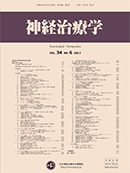Volume 37, Issue 5
Displaying 1-20 of 20 articles from this issue
- |<
- <
- 1
- >
- >|
-
2020Volume 37Issue 5 Pages 707-708
Published: 2020
Released on J-STAGE: July 21, 2021
Download PDF (221K)
-
2020Volume 37Issue 5 Pages 709-711
Published: 2020
Released on J-STAGE: July 21, 2021
Download PDF (406K)
-
2020Volume 37Issue 5 Pages 712-718
Published: 2020
Released on J-STAGE: July 21, 2021
Download PDF (3952K) -
2020Volume 37Issue 5 Pages 719-722
Published: 2020
Released on J-STAGE: July 21, 2021
Download PDF (421K) -
2020Volume 37Issue 5 Pages 723-727
Published: 2020
Released on J-STAGE: July 21, 2021
Download PDF (378K) -
2020Volume 37Issue 5 Pages 728-731
Published: 2020
Released on J-STAGE: July 21, 2021
Download PDF (491K) -
2020Volume 37Issue 5 Pages 732-735
Published: 2020
Released on J-STAGE: July 21, 2021
Download PDF (435K) -
2020Volume 37Issue 5 Pages 736-740
Published: 2020
Released on J-STAGE: July 21, 2021
Download PDF (510K) -
2020Volume 37Issue 5 Pages 741-743
Published: 2020
Released on J-STAGE: July 21, 2021
Download PDF (353K) -
2020Volume 37Issue 5 Pages 744-746
Published: 2020
Released on J-STAGE: July 21, 2021
Download PDF (294K) -
2020Volume 37Issue 5 Pages 747-750
Published: 2020
Released on J-STAGE: July 21, 2021
Download PDF (393K) -
2020Volume 37Issue 5 Pages 751-754
Published: 2020
Released on J-STAGE: July 21, 2021
Download PDF (409K)
-
2020Volume 37Issue 5 Pages 755-759
Published: 2020
Released on J-STAGE: July 21, 2021
Download PDF (1098K)
-
2020Volume 37Issue 5 Pages 760-762
Published: 2020
Released on J-STAGE: July 21, 2021
Download PDF (1660K) -
2020Volume 37Issue 5 Pages 763-768
Published: 2020
Released on J-STAGE: July 21, 2021
Download PDF (778K)
-
2020Volume 37Issue 5 Pages 769-812
Published: 2020
Released on J-STAGE: July 21, 2021
Download PDF (5901K)
-
2020Volume 37Issue 5 Pages 813-816
Published: 2020
Released on J-STAGE: July 21, 2021
Download PDF (1651K)
-
2020Volume 37Issue 5 Pages 817-820
Published: 2020
Released on J-STAGE: July 21, 2021
Download PDF (325K) -
2020Volume 37Issue 5 Pages 821
Published: 2020
Released on J-STAGE: July 21, 2021
Download PDF (174K) -
2020Volume 37Issue 5 Pages 822
Published: 2020
Released on J-STAGE: July 21, 2021
Download PDF (126K)
- |<
- <
- 1
- >
- >|
